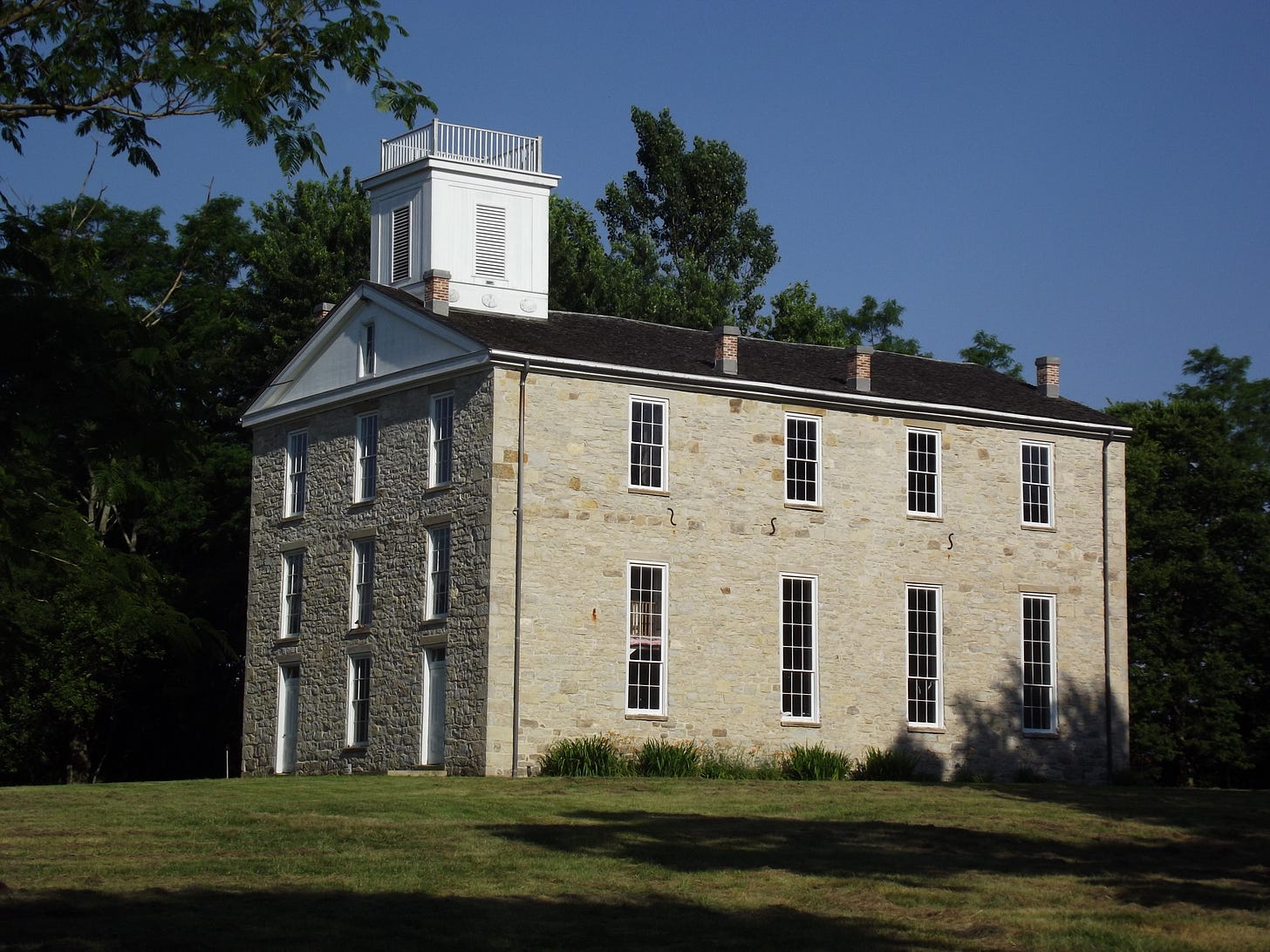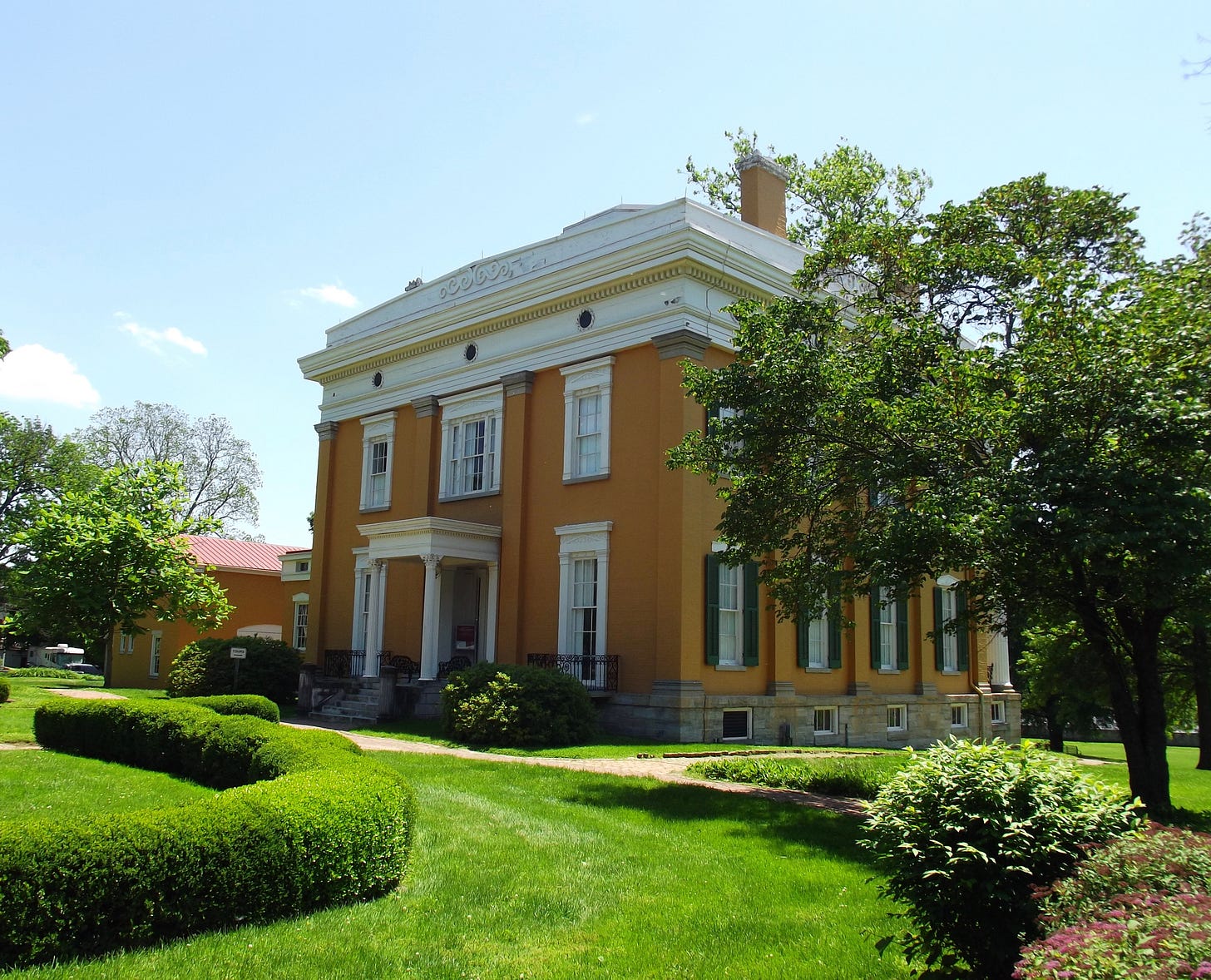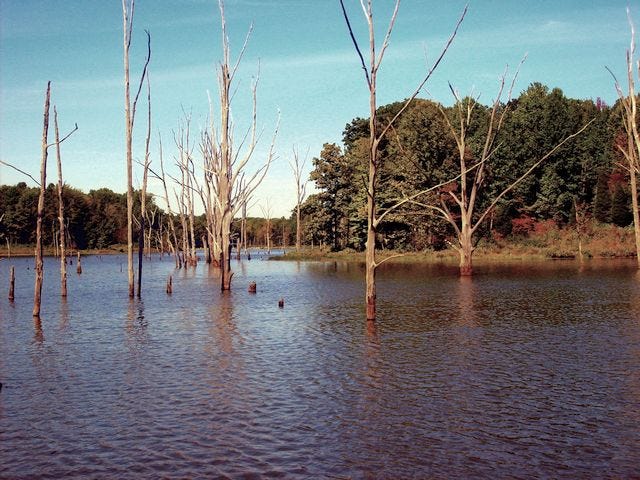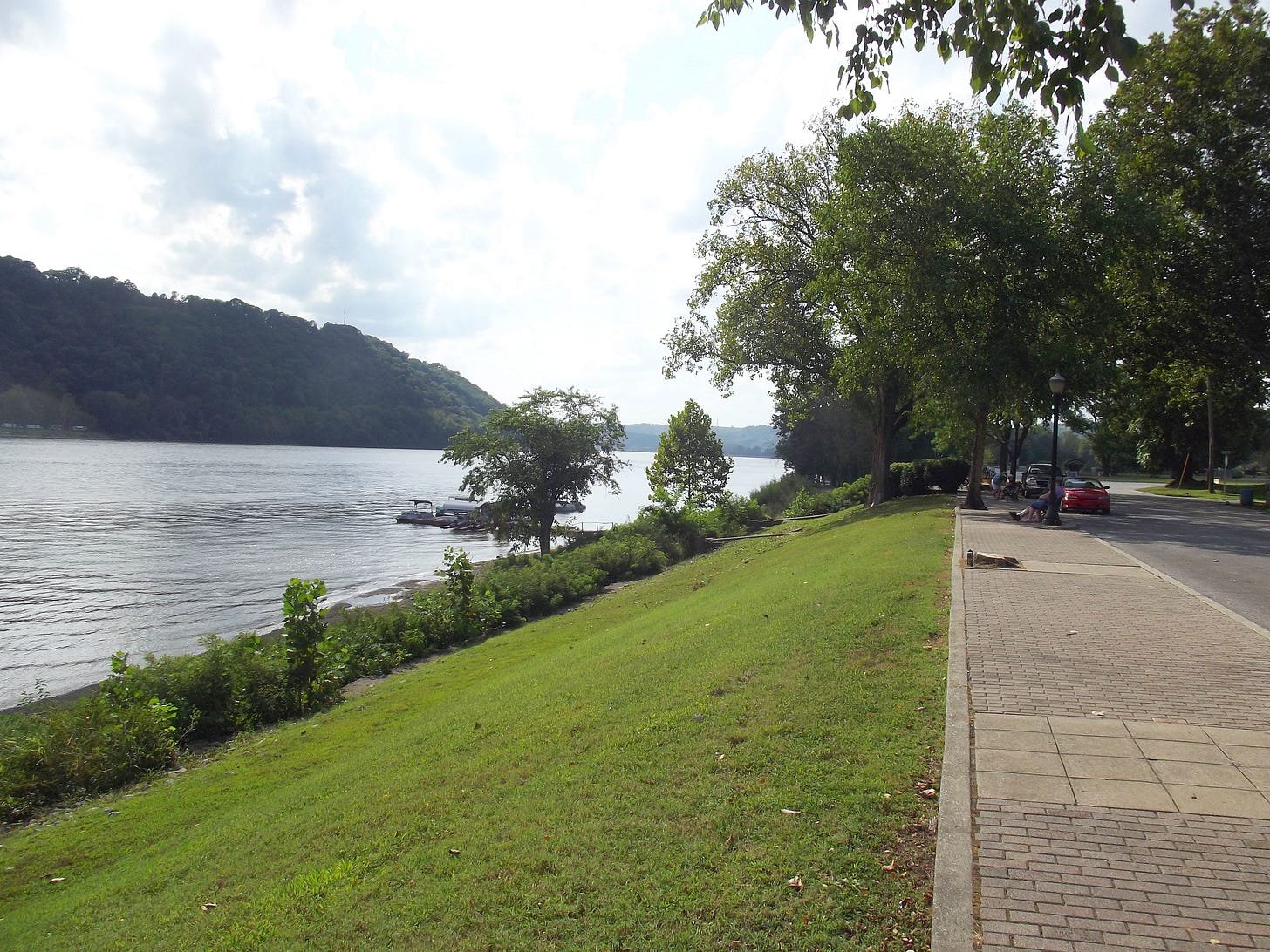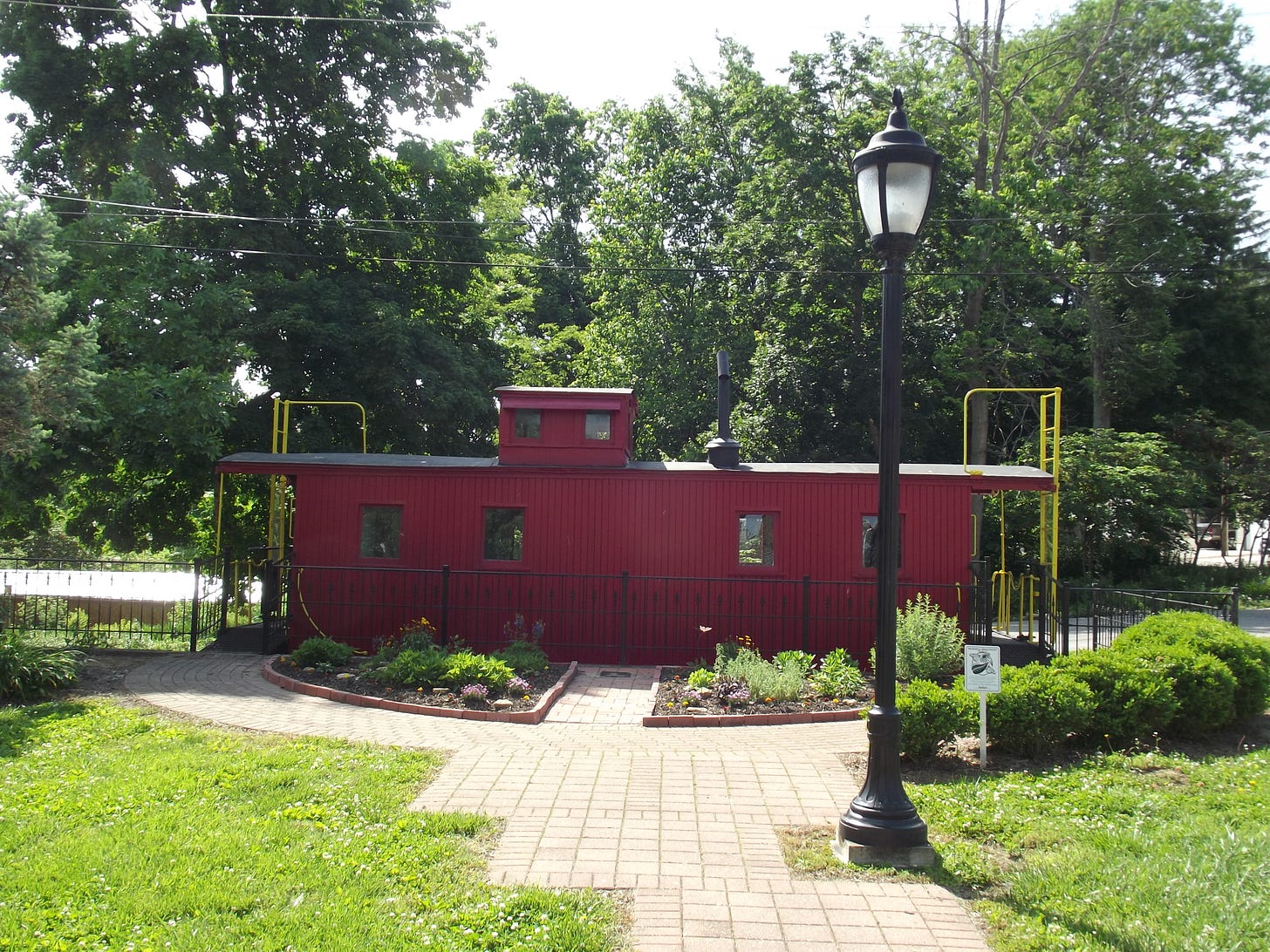Madison, Indiana
The first settlers began populating the site now known as Madison, Indiana around 1806. The town was incorporated in 1809, seven years before Indiana became a state. Its location along the Ohio River caused it to become an important town in the early state's history. In 1836 the Madison & Indianapolis Railroad was completed, connecting the growing city with the new state capital. The state's first major highway was the Michigan Road, commissioned in 1828. Construction began that year and the road was completed in 1834. The Michigan Road, later to become State Road 29, ran from Madison, Indiana to Michigan City on Lake Michigan in the north. It ran through Indianapolis. Therefore, by the 1840's, Madison was connected to the northern part of the state by road and rail.
Over half of the pioneers settling Indiana passed along this road, and this influx of traffic allowed Madison, Indiana to grow. Competing rail lines caused the railroad to fail, and other routes opened, causing Madison, Indiana to fall in importance while other cities grew. The population maintained itself from the Civil War until the late 1900's. A program of downtown renewal has resulted in the creation of a vibrant small city along the banks of the Ohio River. The historic downtown has been revitalized, a river walk built along the river and there are exciting events all year, making Madison, Indiana a picturesque and inviting town to visit.
Eleutherian College
Founded by Thomas Craven in 1848, Eleutherian College became the first school in Indiana that accepted any student regardless of race or gender.
Thomas Craven (March 19, 1792 - August 21, 1860)
A native of Westmoreland County, Pennsylvania, Thomas' parents were blacksmith Thomas Craven and Emmetje Isbrants. The elder Craven served in the Revolutionary War. As a young man, the younger Thomas migrated to Indiana in 1812, after floating down the Ohio River in a flatboat and arriving in Cincinnati. He went to Franklin County to live. He served as a captain during the War of 1812, serving in a blockhouse in Indiana. He moved into Ohio in 1826 and, at age forty-five, entered Miami University. He achieved his lifelong dream of a college education in 1842. In 1848, he donated land in Lancaster, Indiana, Jefferson County to the Eleutherian College. He engaged in several fundraising trips later on to raise money for the institution. Thomas passed away in 1860 and is interred in College Hill Cemetery in Lancaster.
Founding of Eleutherian College
Founded by members of the Neil's Creek Abolitionist Baptist Church with substantial help from Thomas Craven and Lyman Hoyt, the college opened in 1848. The word “elutherian” derives from the Greek word, “Eleutheros.” That word means freedom and equality. By 1857, the college enrolled eighteen black students, ten of which were former slaves. By 1850 enrollment increased to 200, fifty of which were blacks. When public schools for free blacks opened, the school closed. Purchased by Lancaster Township in 1888, the Township operated it as a public school until 1938. The building still stands in Lancaster. It is a part of the National Underground Railroad Network to Freedom. National Underground Railroad Network to Freedom
It is open to the public by appointment only.
Call 812-866-7291 for more information.
812-866-7291
6927 W. State Rd. 250
Lancaster, IN
Lanier Mansion
James F.D. Lanier (November 22, 1800 – August 27, 1881)
Born in Washington, North Carolina to Alexander Chalmers and Drusilla Doughty Lanier, he migrated to Madison, Indiana at age 17 with his parents. He studied law at Transylvania University at Lexington, Kentucky, and then got a job as assistant clerk. He became the Clerk of the Indiana House of Representatives at Corydon. He assisted in the move when the capital transferred from Corydon to Indianapolis in 1825.
Finance
Lanier became involved in finance and became President of the Bank of Indiana, an institution he had helped the State of Indiana establish. He gained majority stocks in the Madison branch of that bank in 1833.
Railroads
By the late 1830's Lanier spearheaded the push to build the Madison and Indianapolis Railroad. This profitable railroad, along with his banking success, led to his accumulation of a large fortune. In 1844 he built his mansion in Madison, on a spot overlooking the Ohio River.
Financial Savior of Indiana
Lanier served twice to save the State of Indiana from financial ruin. In 1844 the State reeled from the massive Internal Improvement Act of 1836. The passage of the Act had strained the State's resources to the breaking point. He arranged with foreign investors to reduce the State's debt in return for transferring the property to the creditors. This saved the State from bankruptcy. During the Civil War the Federal Government requested that Indiana raise and equip troops to fight in the war. Governor Oliver P. Morton requested that Lanier, who by now lived in New York, to lend the State a half million dollars. Lanier complied with the request and followed it up with a later loan of a half million dollars. He received no guarantee of repayment for these loans. The State did repay him by 1870.
To New York
Lanier moved to New York, never again to come to Indiana, in 1851 to manage new businesses he had started there. He died in 1881. The family retained possession of the mansion. His son, Alexander C. Lanier, lived in the home from 1851 until 1895, continuing to develop the home and garden during that time. The State of Indiana acquired the property and restored it. It is now a State Historic Site, open to the public.
The Lanier Mansion
The Lanier Mansion has been designated a National Historic Landmark in 1994. Architect Francis Costigan for financier and railroad magnate James F.D. Lanier designed this 1844 Greek Revival mansion. It is also a State Historic Site, administered by the Indiana State Museum.
The Lanier Mansion is located just off the Ohio River Byway in the city of Madison, Indiana. On a slight rise above the Ohio River, the mansion was the home of James Franklin Doughty Lanier in the 1800's. Fully restored with period furniture the house and garden is now a state-owned museum just a few minutes walk from historic downtown Madison.
601 W. First Street
812-265-3526
Madison Indiana
There are two entrances to Clifty Falls State Park. The North Entrance is on State Road 62 a few miles west of its intersection with US 421. When you pull in this entrance, Clifty Shelter is to the right. This is a big shelter with lots of room for picnicking. There is a large field suitable for soccer, badminton, etc. The south entrance is on State Road 56, which also goes east into downtown Madison. Clifty Inn is on the left of this entrance after you ascend the hill.
Clifty Falls State Park Activities:
1414 Acres
Nature Center/Interpretive Naturalist Services
Shelters
Picnicking
Camping
Hiking Trails
Tennis & Other Games
Waterfalls
Meeting & Conference Facilities - At Clifty Inn
Clifty Inn and Restaurant
Swimming Pool / Waterslide
1501 Green Rd
Madison 47250
(812) 273-8885
Big Oaks National Wildlife Refuge
Big Oaks National Wildlife Refuge began life as a test site for weapons during the opening days of World War 2. It has evolved into a unique wildlife haven in Southeastern Indiana. The Refuge, located near Madison, Indiana on US 421 is one of four National Wildlife Refuges found in Indiana. It served as a weapons testing site until the end of the Cold War in the 1980's. Only a very small portion of Big Oaks National Wildlife Refuge is currently open to the public. This is because large tracts of land contain unexploded ordinance. This ordinance is, of course, quite hazardous.
Military Weapons Testing
The 50,000-acre Nature Preserve occupies corners of three Indiana counties, Ripley, Jefferson and Jennings. Big Oaks is the largest of Indiana's three National Wildlife Preserves. The United States military opened the facility in 1940 for use as a weapons testing area. It saw extensive use during World War II, the Korean War and the Vietnam War. After the 1980's the facility's use began to wan and the military closed it in 1995. The Indiana Air National Guard still uses a 1000-acre parcel as a training range near the center of the property. Large areas of the preserve are off limits to the public due to the presence of unexploded ordinance. The cost to remove this ordinance is prohibitive, so it will remain. It is important when visiting Big Oaks to stay in public approved areas.
History of Big Oaks
After Indiana became a state in 1816, the Amerindian tribes that had occupied the land for hundreds of years had left. Small towns and farmsteads grew up in the rolling ground. It was a peaceful, rural area with no large cities close. During the middle years of the Civil War General John Hunt Morgan invaded the state. He crossed the Ohio River near Corydon, Indiana. He crossed the southern Indiana landscape with his 2000 troops. Part of his route lay across the northern portion of Big Oaks. Two Union officers home on leave managed to capture two of his men within the confines of the Refuge. A monument marks the spot where they performed this deed. Hostilities in Europe and Asia in the late 1930's alerted the Army to the need to test more of its munitions. On December 6, 1940, the military announced its intentions to acquire land in southeastern Indiana. They chose this area because it was lightly populated and had nearby roads and rail lines. The military relocated over 400 families and began using it, now known as Jefferson Proving Ground, by the end of the year.
Wildlife Returns
Over the course of the military's use of the area, they surrounded it with a tall chain link fence topped by razor wire. Several military personnel and officers served at the base, which also employed many civilians in the area. Thus cut off, the land slowly reverted to forest and grassland and wildlife thrived. By the time the facility closed in 1995 huge tracts had reverted to the forest it had originally been. Deer, wild turkey and other wildlife thrived. After closing, debate over what to do with it occurred over the next few years. At length the government decided to turn it into a National Wildlife Refuge. Though the military still owns the land, the National Park Service manages the parcels within the Refuge. 200 species of birds, 46 species of mammals, 24 species of amphibians, and 17 species of reptiles are found on the refuge.
Visiting Big Oaks National Wildlife Refuge
The area around Old Timbers Lake in the northwest portion of the Refuge is the only area currently open to the public. It is a seventeen-mile drive from the Visitor Center. The Center is about seven miles from Madison, Indiana on US 421. There are several miles of roadway around the lake, great for an afternoon drive or a day hike. Picnic areas are scattered around through Big Oaks National Wildlife Refuge. Hours are Monday and Friday 7:00 AM to 4:30 PM and the second and fourth Saturdays of each month. An admission charge is paid to enter the park. All visitors must view a safety video and sign an acknowledgement of danger form prior to entering the refuge.
Things to Do
Visitors may participate in several activities in the Refuge. Deer hunting and turkey hunting is permitted in designated areas during designated times. Anglers may fish in the 165-acre Old Timbers Lake. Bank fishing, only as boats are not permitted on the lake. Hikers can hike on the designated trails or on the many roads in the public area. Photographers will find many subjects for their camera, as the wild scenery in the Refuge is beautiful. Waterfowl and other wildlife will provide willing subjects. Refuge staff provides guided tours with advance reservation. There are several popular events scheduled throughout the year. See the website for informational brochures, event schedules and current hours of operation.
Big Oaks National Wildlife Refuge
1661 W. JPG Niblo Rd
Madison, IN 47250
Lamplighter Riverfront Park
Walk or picnic along the river as you enjoy this wonderful Lamplighter Riverfront Park. Riverboats frequently stop here, and there is dining either on or overlooking the river.Lamplighter Riverfront Park is close to the Madison Mainstreet Business District. Public launch site is available.
Lamplighter Riverfront Park consists of about two acres on the east side of Madison. The trail that passes to the west runs all along the Ohio River riverfront.
Outdoor lamps located in Lamplighter Riverfront Park provide plenty of nighttime illumination and the park has plenty of picnic tables and benches to watch the mighty Ohio River as it passes by. Located on the banks of the Ohio River between Broadway and West Street, Lamplighter Park features a gazebo, benches, and several overlooks which provide a panoramic scenic view.
Madison, Indiana
between Broadway and West Street
Madison Railroad Station
On the Heritage Center grounds is the restored Madison Railroad Station, a brick Victorian-era passenger depot noted for its octagonal waiting room that is over two stories tall. The Pittsburgh, Cincinnati, Chicago, and St. Louis Railroad Company constructed the building in 1894. After discontinuing passenger service in 1935, the railroad used the building for storage until the 1960's. The Wilco Electric Company used the building until its purchase by the Jefferson County Historical Society in 1986. The Historical Society restored the structure, and it now houses a railroad museum.
615 W. First Street
812-265-233
Tourism Information
601 W 1st St,
Madison, IN 47250
Phone: (800) 559-2956
© 2023 Paul Wonning






